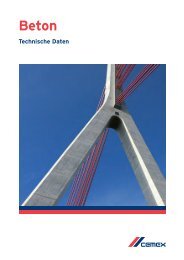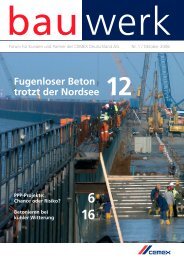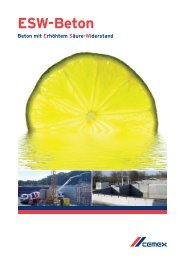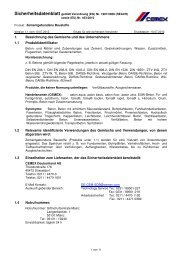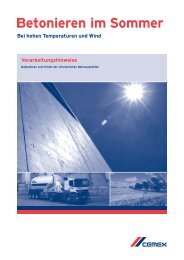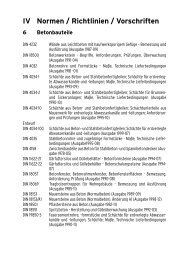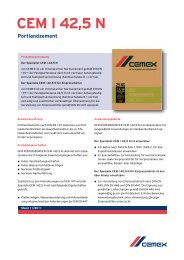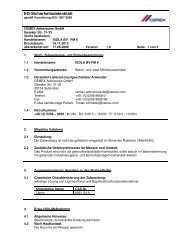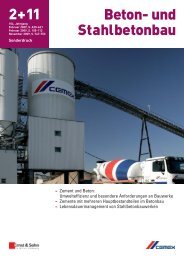building a better future - Cemex
building a better future - Cemex
building a better future - Cemex
Create successful ePaper yourself
Turn your PDF publications into a flip-book with our unique Google optimized e-Paper software.
assessing our water usage and<br />
impacts<br />
Through continued engagement with the IUCN, CEMEX<br />
has created the basis for a materiality analysis addressing<br />
water-related risks and opportunities, and helping define a<br />
roadmap toward strong management of water issues.<br />
The availability of clean, potable water has become a matter<br />
of global concern. Less than 0.5 percent of global water<br />
resources are available for human consumption, even as<br />
populations continue to grow and widespread water contamination<br />
and the effects of climate change further stress<br />
supplies.<br />
While it is estimated that the concrete value chain represents<br />
only 1 percent of global industrial water demand<br />
and 0.2 percent of total global water demand, the risks of<br />
shortages are increasing. Currently, 9 percent of CEMEX<br />
operations are located in officially designated water stressed<br />
zones, based on water data from the WBCSD Global Water<br />
Tool. In addition, water regulations in many of CEMEX’s<br />
countries of operation are now imposing time-limited water<br />
abstraction licenses, stricter water metering requirements,<br />
and new water-discharge constraints.<br />
These developments, combined with increased stakeholder<br />
demand for disclosure around water usage, demonstrate the<br />
need for proactive management of water resources in our<br />
business. To address this challenge, CEMEX worked with the<br />
IUCN in 2011 to produce the following deliverables:<br />
1. Setting the Scene, a research document evaluating<br />
global water issues, associated stakeholders, key issues<br />
of water use in CEMEX’s productive processes, and<br />
methods for assessing water impact.<br />
2. A water benchmark to understand CEMEX’s water<br />
usage in an industry context, and to assess peer best<br />
practices.<br />
“It is expected that within two decades, the<br />
collective demand of humans for water will<br />
exceed foreseen supply by about 40 percent.”<br />
— Water Resources Group, 2009<br />
3. A data-gathering template to enable standardized<br />
reporting on water usage, metering, watershed conditions,<br />
best practices, and local challenges across all of<br />
our business segments and operations.<br />
4. Geographical mapping of more than 2,000 CEMEX<br />
sites—cement, ready-mix, and aggregates facilities—<br />
for comparison with areas identified as water-stressed<br />
zones.<br />
5. A materiality assessment, based upon findings of the<br />
preceding steps, to gauge and prioritize our water risks<br />
and opportunities.<br />
The results of our final materiality assessment will become<br />
available in early 2012 and will be fully discussed in our<br />
2012 Sustainable Development Report.<br />
advancing our waste-reduction<br />
strategy<br />
Our processes generate waste that is disposed of according<br />
to our own standards and the requirements of local<br />
regulations. In terms of operational wastes, cement-kiln dust<br />
represents the largest amount of waste we produce. We now<br />
reuse it in the production process and in other processes. As<br />
we follow the waste hierarchy, we seek to monitor, minimize,<br />
reuse, and recycle our wastes. The actions we undertake in<br />
this area include:<br />
• Monitoring of hazardous and non-hazardous waste generation<br />
in all our operations<br />
• Replacing primary aggregates with other discarded materials<br />
(e.g. demolished concrete)<br />
• Reusing and recycling, as much as possible, the fresh concrete<br />
returned from construction sites<br />
< previous 27 next>



